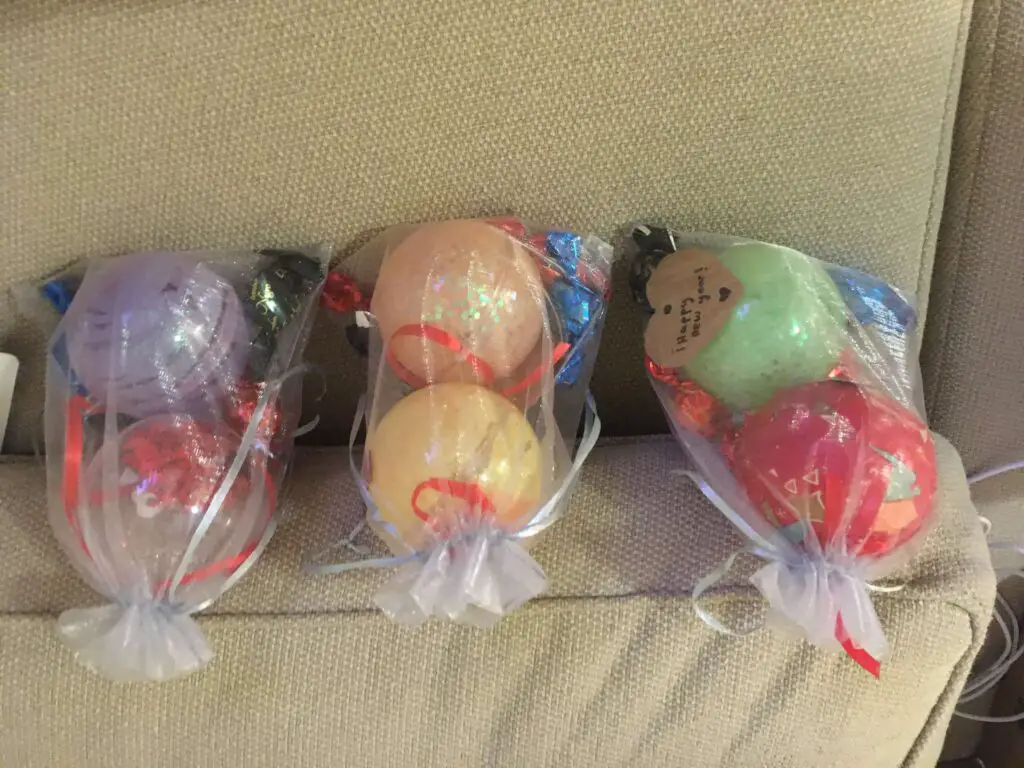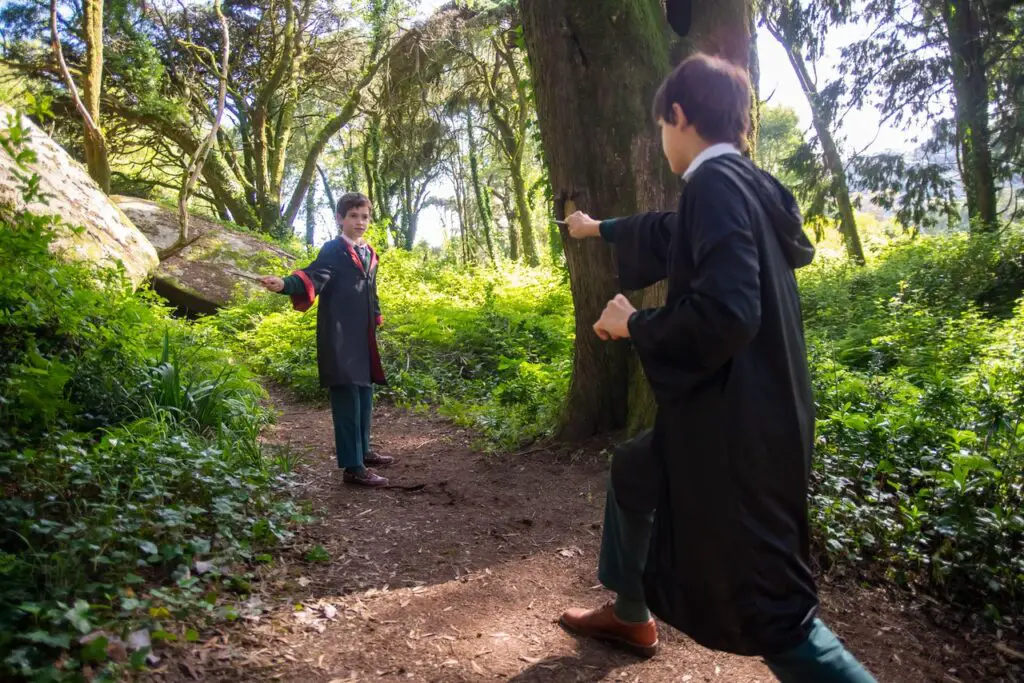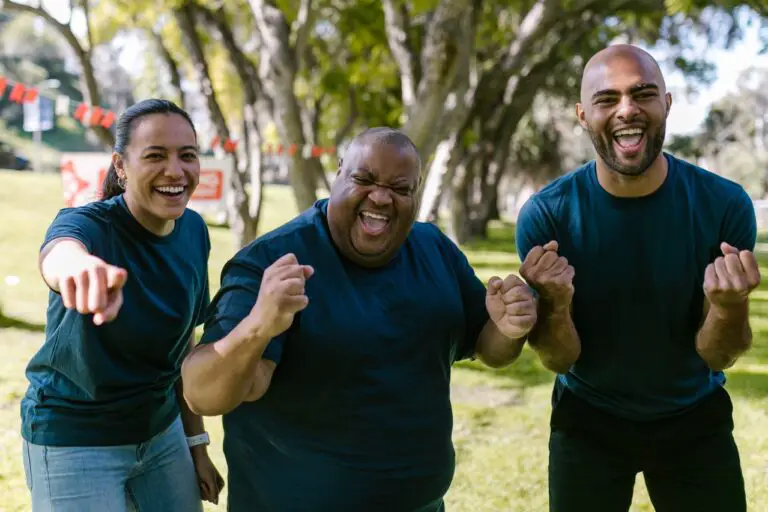I love learning through projects. It’s one of the best ways to engage EFL/ESL students while challenging and improving their English skills. Projects may take a while, but they’re always worth it.
If you’re an EFL/ESL teacher who doesn’t have to follow a strict curriculum or set of lesson objectives, and can instead plan your own classes, projects are a great way to change the pace of your lessons.

The nine project ideas in this list can be used with any age and English ability, although some might not be ideal for absolute beginners and very young children. In general, they take between 1 and 10 sessions to complete.
I’ve been running EFL/ESL projects for years with great success, and I’ve added tips to each of them, based on my experience.
Before we get stuck in, it’s worth taking a step back and thinking about the purpose of our projects.
Why do we do projects in EFL/ESL?
Projects are fun. That’s a pretty good reason to do them in your classes; when students are enjoying themselves, they’re motivated to learn.
However, it’s not enough. Playing video games is fun, but I wouldn’t recommend that for EFL/ESL.
When choosing a project, think about what your students are going to learn and how. What’s the purpose of the activity?
Learning new vocabulary through organic acquisition and gaining fluency in relevant conversation could be the purpose. Or, a focus on specific words and grammar. It could be to practice language used for communication in a team, or to learn about the customs and cultures of other countries.

There’s no right answer here. As long as you can be sure the project will benefit the students by developing their knowledge and skills in English, you’re doing it right.
Some teachers like to identify the goals of the project before deciding on what they’ll actually do. That’s a good way of aligning with a long-term curriculum. However, it limits the range of projects you can choose from since many won’t achieve the goals you want.
The other approach is to choose a project first. The main benefit of this is that you can pick a project you know your students will engage best with and figure out the goals later. The drawback is that when you come to setting goals, you can only choose within the limits of the project.
Okay, that’s enough setup. Let’s get straight to the list!
- Short film
- Cooking
- Run a small business
- Cultural discovery
- Arts and crafts
- Dramatization
- Plan a vacation
- Create a community
- Table-top role-playing game
1. Short film
This list is in no particular order, but I had to put this entry at number one. It’s the type of project I’ve had most success with, and the one I’ve done more times than any other. By far.
You can create films about anything. I’ve had classes make spooky movies for Halloween, murder mysteries, documentaries, and fantastical adventures. I’m currently making a compilation of English jokes with one of my private classes.
Be careful, though. Films can take a long time to create, and if you aren’t pushing students to progress, kids especially can end up wasting hours on trivial things.
Here is my general timetable for film projects:
- Session 1: Ideation. Come up with the genre and concept of the film. Decide major characters and consider where filming will take place and if you need any props or equipment. Make a list (or storyboard) of all the scenes you’ll need to film.
- Session 2: Plan the first scene. Collaboratively write the script for the first scene and do a practice run, figuring out where to film and what problems might arise.
- Session 3: Record the first scene and plan the next. Make sure students bring appropriate costumes and props for the first scene. What you film here will be in the final product. If you have time remaining, start planning the next scene.
- Remaining sessions: Alternate between planning and recording scenes until you’ve finished them all.
IMPORTANT: If you’re doing this project with children/teens, check parents are okay with it. And never share video footage (with other students, or posting online) without first asking permission.
TIPS
- Keep the film short. As a general rule, each minute of film takes about an hour of lesson time. Avoid planning long, elaborate stories – you won’t have enough time to finish.
- Keep scenes short. Chop scenes up into mini-moments which you can capture quickly. Long scenes are harder to get right and require multiple takes as students struggle to remember their lines.
- Write or print the script in large letters so students can see their lines from a distance. This way, they can quickly glance at the script behind the camera before you start the scene instead of holding the script in their hands.
- Expect giggling. When students make mistakes or get nervous, they’ll start laughing. It happens with professional actors. Be patient and encourage students to refocus quickly.
- Use a basic movie editor (iMovie is great) to put scenes together. If your students are older teens or adults, you could even get them to edit it themselves.
2. Cooking
If you have access to a kitchen, cooking can be a great way to learn practical English.
Not only will students follow instructions on a recipe (reading practice), but they’ll learn vocabulary that rarely appears in a textbook. Ingredients like baking soda and lemon zest, or verbs like whisk and dice.
Logistics are the biggest challenge. Choosing something simple you can prepare and bake in one session is probably the best approach, then you don’t have half-cooked ingredients lying around for a week between classes. You can use sessions before and after to plan and practice related language.

While simplicity is good, I recommend using authentic recipes. Perhaps something your grandmother used, which has real English and even old-fashioned measurements. That way, you expose them to some of your culture.
IMPORTANT: Make sure you know of any students with allergies in the class, so you can avoid certain ingredients if necessary.
TIPS
- Baked goods like cookies are best for kids. They’re quick, easy, and can be taken home at the end of class.
- Plan for at least 10 minutes of cleaning up time.
- If you need to pre-heat ovens, remember to do that at the start of the lesson.
- If you don’t have cooking facilities like an oven, you can make a salad or other cold meal in the classroom.
3. Run a small business
The idea here is simple. Think of a product to either buy or make, then sell it for a profit. The prospect of earning a little money is motivating, and students will learn a ton of relevant English as well as some practical business skills.
However, it’s not for everyone. Young kids will struggle, and adults who already work in business may think it’s below them.
Here’s an example of a successful business project I ran with a small group of teenagers.
Christmas was approaching. The group had the idea of making baubles and other decorations and selling them in bundles.
We did some calculations and figured out our expenses and the price we’d need to sell the products for in order to make a profit. Everyone contributed an equal share, and we bought clear plastic baubles, glitter, glue, and lots of other materials. We spent approximately 25 euros.
In the weeks leading up to Christmas, we made some beautiful baubles, tags for presents, and boxes covered in wrapping paper.
The students sold the decorations to family and friends. The overall revenue was about 60 euros, so we made a profit of 35.

Okay, so we hardly set the world on fire with our profits. But that wasn’t the point. The purpose of the project was to learn some business skills in English, develop the ability to communicate in a team, while also learning language related to decorations, crafts, and Christmas.
TIPS
- Getting the product right is key. Make sure students choose something that they can sell, even if it is only to generous friends and family members.
- Make sure production isn’t too difficult or time-consuming. You don’t want your classes to turn into factory work for weeks on end.
- If your students are responsible enough, have them handle the money.
- Divide the costs and profits equally. Having an equal share system is the best strategy, with everyone contributing a small amount to cover initial expenses and receiving an equal amount of the final pot.
- This type of project is long, but near the end, there won’t be that much to do. Once the products are ready, students can sell them. At that point, you can return to normal classes with a brief business update in each session.
- Set a deadline for the end of the project. At a certain point, you have to finish, even if all the products aren’t sold.
4. Cultural discovery
A cultural discovery is a flexible project you can do with all ages and abilities. In essence, it involves students researching a different culture and presenting it to the rest of the class in some form.
The way I like to do this is with a cultural festival day (or week, if you have a large class). Set the date in advance, and on that day/week, everyone will share what they’ve found.

People can dress up, bring food, play music, give mini-presentations, and ideally, a mixture of these things. The more the better.
With a few different groups sharing the culture they’ve been learning about, you can create a powerful experience.
TIPS
- Give students time to research and prepare, but not too long. If the big day is months and months away, they’ll waste a lot of time. Make things urgent, so they work fast.
- Consider sharing your own culture at the start as an example of things you’d like to see.
- Groups of 2-3 work best in preparing this kind of thing, but if you have a larger class (20+) have bigger groups and fewer cultures. If you have too many cultures (more than 5), the “cultural festival” will take too long and things will get muddled.
- Encourage students of different backgrounds to share their own cultures. Alternatively, people who have been on holiday somewhere can research that place and maybe bring some photos and souvenirs from their trip.
5. Arts and crafts

There are hundreds of different arts and crafts projects you can do with your class to learn about almost anything. Some can be as short as a single lesson, while others can take a full term.
I prefer longer-term projects as you can create some impressive final products.
But things don’t have to be elaborate and challenging. A lot of the time, arts and crafts acts as a great vehicle for learning English, with the final creation as a secondary bonus.
If you’re looking for ideas for arts and crafts projects, I actually have a whole article for you: How to Use Arts and Crafts in EFL/ESL + 7 easy activities. There you can also learn my strategy for getting the best out of these projects.
TIPS
- Bring extra materials and equipment for students who forget to (or can’t) get their own, and those who mess up the first attempt.
- Keep instructions slow and simple, and spend time helping students who are struggling.
- Have extension activities for students who get things done at lightning speed.
- Set aside time for tidying up, and assign everyone a job to ensure the room gets cleaned quickly.
6. Dramatization
This project idea is similar to the first entry in the list – making a short film. There’s acting, story creation, and lots of speaking English.
But they’re far from identical. The kind of dramatization I use in my EFL/ESL classes is a lot more free-form and takes much less time.
First of all, performance in front of parents/friends is not required – most of the time it’s just for the rest of the class to see. This is certainly not a whole-school production (although you can definitely try that if you’re feeling brave!)
Secondly, scripts are optional. With some classes, I’ll encourage them to avoid the use of scripts, and instead use their English skills to communicate ideas how they see fit. There’s an element of improvisation in what they say.

Thirdly, scenes are longer and don’t need to be perfect. When making a film, you want to get the best footage, so shorter clips are better. But in a dramatization, there’s no recording. That means students can keep scenes going for a lot longer (especially when improvising lines).
Finally, dramatizations require much less in the way of costumes and props. A lot more can be left up to the imagination of the viewer and you don’t need to plan things before the class.
I like to give students a prompt and see what they come up with. For example, “your region is suffering the worst storm in a hundred years. Gather your friends and find safety in your house on the other side of town.”
The activity works best in a single session. Each performance should take 2-3 minutes. Plan for two thirds of the class to be planning and practicing, while the final third is performance.
TIPS
- Kids often get silly when left to plan out a story on their own. Make sure they’re on task.
- Sometimes dramatizations can end up being mime-stories with less confident students. Reinforce the idea that this project is for practicing spoken English.
Dramatization is a sister-activity to role plays. Role plays, however, are fully improvised, with no time to prepare. I absolutely love them.
To learn why I think they’re so great, read: Why All EFL/ESL Teachers Should Use Role Play Activities and to learn the difference in terms, check out: Dramatization vs Simulation vs Role Play: Guide for EFL/ESL
7. Plan a vacation
Planning the details of a vacation gets students learning real, practical English, discovering new places, and developing the language needed to work in a team.
Depending on the age and ability of your students, you can go quite deep into this.
With younger, less proficient students, you can look at some destinations on a map and create a basic plan of what you want to do on each day. It’s a great way to teach time connectors like “after that”, “the next day,” and “later that day”.

With more confident students, why not have them research the price of real flights, hotels, and tickets? Give them a budget to work with. Write a list of things you need to take in your luggage, and consider about what kind of transport you’ll need when you’re there.
Anyone who’s planned a vacation knows there’s a lot to think about. Learning how to do all of that in English covers so many aspects of useful, applicable language.
TIPS
- With children, letting their imaginations run wild is often more productive than sticking to the limitations of reality. Let them stay at a five star hotel if they want.
- At the end of the planning, you can role play some special imaginary moments from it.
- Keep the vacation short – students will probably get bored planning a year-long trip around the world. A week’s itinerary is plenty.
The only downside to this project is you don’t actually get to go on the vacation…
Or do you?
8. Create a community
Have you ever played the Sims? This project draws a lot of inspiration from that wonderful game, but in a non-virtual format.
Coming up with characters is fun. Thinking about what they look like, their personalities, their background, where they live and work, and their relationships with people around them… it’s a joy. I’ll admit, perhaps it’s not for everyone. But if you have a creative, social class, this could work a treat.
The best place to start is a small neighbourhood. You can draw up a map together if you like, or keep things all in the imagination.
Get each student to come up with a character. Give them some prompt questions depending on their ability and maturity, and have them flesh out the character as much as possible. If you have a large class, have small groups come up with households.

You can go through plenty of vocabulary here. Physical appearance: tall, short, brown hair, green eyes, etc. for beginners. And with higher ability students, words like slender, auburn hair and freckles.
Personality and background come next. Think about strengths and weaknesses. Life ambitions and short term goals. Family history. Secrets. Younger students will struggle with this – they don’t have the maturity to put themselves so deeply in other people’s shoes, so don’t push too hard.
Then, you can join the dots. Are some of these people friends? Enemies? Colleagues or old school mates? A good exercise is to have everyone mingle around the classroom and think up connections with other characters they bump into.
Once you have a community set up, the next stage (optional) is to role play or dramatize interactions and events. Have students get in character and act out a party, accident, or confrontation at work. The opportunities are endless.
TIPS
- This activity won’t work with everyone. Some people won’t find it as exciting as others, and some might be uncomfortable acting things out. That’s fine. Don’t push it if you see things getting negative.
- Come up with a character yourself. Make them clearly defined and colourful to set the tone for everyone else.
- Look for character profile prompts online. Authors often use a series of questions to flesh out their characters, so there are plenty of resources available.
9. Table-top role-playing game
This is my favourite activity. It just about makes it onto this list as a “project” because it’s an extended activity that takes place over multiple classes. But really, it’s an ongoing game/story.
Dungeons & Dragons is the most famous table-top role-playing game (TTRPG), popularised by Stranger Things and various YouTube channels like Critical Role.
Essentially, players (students) create an adventuring character and take actions and decisions in an imaginary world narrated by the Game Master (in this case, you, the teacher). While there are rules, players can try whatever action they want. It’s full of role-play, improvisation and conversation.
Here’s a video of Vin Diesel playing to show you how fun it can be.
I have three Dungeons & Dragons games going on with classes at the moment. My students adore it. But it doesn’t have to be D&D. In fact, the rules are pretty complicated, and not everyone is into fighting orcs and dragons and that kind of thing.
Instead, you can choose one of the many other TTRPGs out there, with different themes and rules. With younger students, I’ve created a few games of my own that avoid complexity and favour interaction with the world using their English skills.
And that’s what this is about. Learning English. Having fun is great, but where TTRPGs really shine in EFL/ESL is for language acquisition.

Learning new vocabulary in the story is relevant and valuable. Getting their sentences right in a tense conversation with the Queen is vital – they’re motivated to learn new things and improve what they know. You can use their exploration to introduce new words and phrases, without it feeling forced.
The improvement I’ve seen in students’ ability and confidence using TTRPGs is astonishing. That being said, with the wrong approach, things can go off the rails pretty quickly, and students get frustrated. Another drawback is you can only do it with small groups (6 or 7 at most, 3-4 is optimal).
The Enchanted RPG
I’ve made a role-playing game specifically for ESL!
Find out how I designed it and how you can start playing in this video.
And subscribe to my YouTube channel for more updates!
TIPS
- Make sure students understand the idea of the game. They can imagine what their character would do, but can’t invent things about the world.
- Ensure students work as a team, both in-game and out of the game. If their characters split up and do different things, the whole experience falls apart.
- Avoid players fighting against each other. This almost always leads to unnecessary tension between students.
- Prepare in advance. There’s quite a lot of planning and preparation to run a game like this, but if you get it all done early, you won’t have so much to do week to week.
Conclusion: Pick and choose
Not all of these project ideas will work for your specific class. People have different personalities and interests, meaning each group is unique. One class might love the excitement of role playing a fantasy adventure. Others might think that’s lame and prefer to learn about cultures in the real world.
As a teacher, you know your students better than anyone else. That means you’re in the best position to choose the project you think is best for them.
So pick the ones you think will work and adapt them. Apply your own slant and give your students agency, too. Together, you’ll make the project a worthwhile and memorable experience.
If you’re looking for more games and activities, check out my other lists:
9 EFL/ESL Speaking Games & Activities Perfect for Beginners
9 EFL/ESL Games & Activities for Intermediate Learners
9 EFL/ESL Games and Activities for Advanced Learners
9 High Energy EFL/ESL Games for Boosting Vocabulary
9 Engaging Homework Ideas for EFL/ESL: No worksheets!
9 Exciting EFL/ESL Activities for Writing & Spelling
9 Fun EFL/ESL Games & Ideas With Standard Playing Cards
9 EFL/ESL Games With No Materials or Preparation Needed
9 EFL/ESL 5 Minute Games Every Teacher Needs to Know
9 Superb EFL/ESL Games & Activities Using Just Pen & Paper
9 Classy EFL/ESL Games & Activities for Adults (+ tips)
9 Confidence-Boosting EFL/ESL Speaking Games for All Levels
9 Exciting Flashcard Games for EFL/ESL Classes








